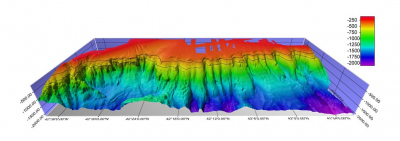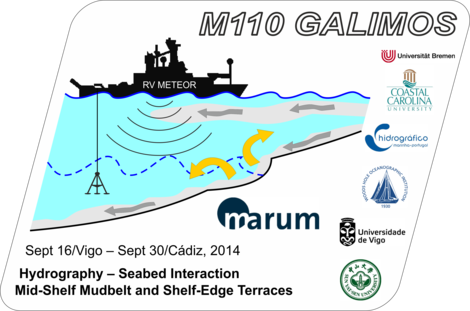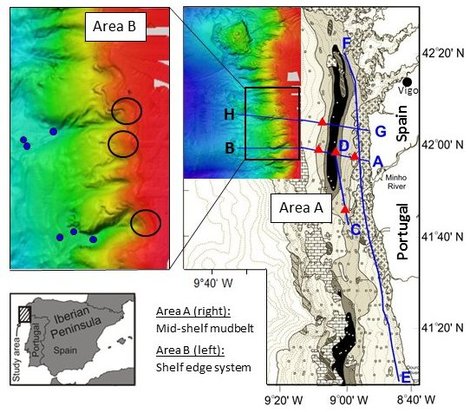Die Inhalte dieser Seite sind leider nicht auf Deutsch verfügbar.
Seitenpfad:
- Startseite
- Forschung
- Expeditionen
- 2014
- METEOR M110
METEOR M110
M110 GALIMOS
Monitoring the interaction between Oceanographic elements and Sedimentary seabed structures at the GALIcian margin.
Chief Scientist: Dr. Till J.J. Hanebuth
During the past years, we reconstructed the long-term depositional processes which occur on the continental margin off NW Iberia. Now, expedition M110 GALIMOS will target on the bottom-near processes in the present oceanographic and sedimentary systems. The aim is to compare these modern dynamics with the long-term development and to integrate these new data into process-based numerical models. Our activity will focus on a) the area of the late-Holocene mid-shelf mudbelt, and b) the shelf edge where internal waves seem to interact with the seabed in a remarkable apparentness.
This expedition focusses on the two areas of most intense interaction between the hydro-graphic and sedimentary regimes at the NW-Iberian continental margin.
(1) Mudbelts occur ubiquitously on shelves and are highly sensitive to environmental changes but their individual depositional dynamics remain widely speculative. Geometry, volume and age structure of the Galician mudbelt are understood from own studies. The specific hydrographic conditions control-ling settling, resuspension and deposition will be target of this cruise by monitoring water column and nepheloid layers. The data will be integrated into a morphodynamic model to simulate the mudbelt formation and to identify the major environmental forces.
(2) Shelf edges as critical interfaces separate contrasting oceanographic and sedimentary regimes. While the interaction of hydrography with the shelf edge, especially through internal waves, and the associated sediment re-suspension are generally understood, the resulting direct seabed structuring remains obscure. The Galician deeper shelf edge shows a built-up of two terraces, offering a unique chance to observe in-situ seabed shaping and material behaviour, as the result of the exposure to internal waves, in concert with monitoring the water column and intermediate layers. The data will allow simulating the wave/seafloor interaction and developing a conceptual shelf-edge model.
Monitoring the interaction between Oceanographic elements and Sedimentary seabed structures at the GALIcian margin.
Chief Scientist: Dr. Till J.J. Hanebuth
During the past years, we reconstructed the long-term depositional processes which occur on the continental margin off NW Iberia. Now, expedition M110 GALIMOS will target on the bottom-near processes in the present oceanographic and sedimentary systems. The aim is to compare these modern dynamics with the long-term development and to integrate these new data into process-based numerical models. Our activity will focus on a) the area of the late-Holocene mid-shelf mudbelt, and b) the shelf edge where internal waves seem to interact with the seabed in a remarkable apparentness.
This expedition focusses on the two areas of most intense interaction between the hydro-graphic and sedimentary regimes at the NW-Iberian continental margin.
(1) Mudbelts occur ubiquitously on shelves and are highly sensitive to environmental changes but their individual depositional dynamics remain widely speculative. Geometry, volume and age structure of the Galician mudbelt are understood from own studies. The specific hydrographic conditions control-ling settling, resuspension and deposition will be target of this cruise by monitoring water column and nepheloid layers. The data will be integrated into a morphodynamic model to simulate the mudbelt formation and to identify the major environmental forces.
(2) Shelf edges as critical interfaces separate contrasting oceanographic and sedimentary regimes. While the interaction of hydrography with the shelf edge, especially through internal waves, and the associated sediment re-suspension are generally understood, the resulting direct seabed structuring remains obscure. The Galician deeper shelf edge shows a built-up of two terraces, offering a unique chance to observe in-situ seabed shaping and material behaviour, as the result of the exposure to internal waves, in concert with monitoring the water column and intermediate layers. The data will allow simulating the wave/seafloor interaction and developing a conceptual shelf-edge model.
- Instrumentation:
• Shipboard Multibeam, SADCP, PARASOUND
• Water column profiling: towed CTD/OBS/LADCP, Rosetta/CTD
• Tripod mooring: CTD, 3 CM/OBS, LADCP (1200 kHz), LISST; 3 deployments
• Conventional mooring: CTD, 2 CM/OBS; 2 deployments
• Particle camera (ParCa)
• Remotely Operating Vehicle (ROV; 5 deployments
• Water-column and seabed sampling: Rosetta/Niskin bottles, Rumohr corer
- M110 GALIMOS participating institutions:
• MARUM, University of Bremen, Germany
• Faculty of Geosiences, University of Bremen, Germany
• Dept. de Geociencias Marinas y Ordenación del Territorio, Universidade de Vigo, Spain
• Instituto Hidrográfico, Lisbon, Portugal
• School of Coastal and Marine Systems Science, Coastal Carolina University, SC, USA
• Applied Oceanography Dept., Woods Hole Oceanographic Institution, MA, USA
• Vlaams Instituut voor de Zee, Belgium
• Sun Yat-Sen University, Guangzhou, China





